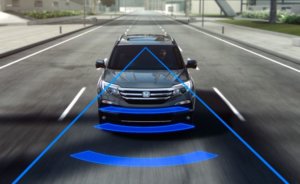Do We Need Automatic Braking?

Do We Need Automatic Braking?
After the highly publicised speed limiters hit headlines earlier this year, we at TerraClean are interested in what other new technologies could be on the horizon for new vehicles in the near future; we are interested to know what you the motorist and car buyers think about them……. Good, Bad …… an infringement of our bloody liberties, let us know your thoughts. A topic that has cropped up a few times over the years is AEB or Autonomous Emergency Braking to you and me. Which in theory means we as drivers won’t necessarily need to slam on the brakes as much…… In theory.
- TerraClean is another modern technology and process that can be used to improve the performance of vehicles, if you're interested in seeing what TerraClean can do for you, put your postcode in the top and find your nearest dealer.
How does it work?
AEB will use light detection and radar, or even camera sensors to collect data to work out if a dangerous situation is developing. If it identifies that the driver will need to take action, a warning will show or sound. If the driver doesn’t take action to avoid an upcoming collision, the vehicle will apply the brakes automatically. Sounds simple but does it work?
Who is using AEB?
Toyota and Honda are already using similar technology although they aren’t currently using the abbreviation AEB, it is more commonly called pedestrian detection, forward collision warning or low-speed automatic braking. It uses the same radar or camera premise to detect potentially hazardous situations, warning the driver then taking action if the driver fails to react.
Volvo
AEB is no new concept, since the very idea of self-driving cars was thought up, automatic braking would have been at the forefront of engineer’s minds. Elon Musk has even recently come out pledging to have roadworthy self-driving Tesla ‘robotaxis’ by mid-2020. Would you trust one to find you and drop you off in the right place, let alone be safe? But let’s hope AEB has developed since 2017, after this video showing Volvo ‘testing’ their auto-braking, and subsequently running over their Managing Director surfaced online! The car is seen reversing and then accelerating towards him, showing absolutely no sign of trying to slow down. This demonstrates how very wrong automated systems can be, though he clearly had faith in their system. Sadly that trust was misplaced as he narrowingly avoided getting seriously hurt. Though it later came out that it wasn’t actually that MD but they still ‘strongly recommended’ its dealers, partners and customers never perform test towards real humans, as obvious as it may seem.
Is it needed? The future of driving...
The real question is, is this needed, should we as drivers trust it or simply consider it as a backup? This, as with self-driving vehicles begs the question of who would be held accountable if someone got hurt. AEB, ABC, CFG are these just more abbreviations that will just get lost in the sea of car technical jargon? Or a forgotten accessory on the long list of optional features. Some may think that this is a precursor to the self-driving car, a small step in the direction of humans no longer needing to be in full control of their vehicles. Regardless of what this could lead to, the EU Parliament have voted to make this part of their new safety standards for all new vehicles by 2022. Alongside a list of other “safety” features set to make driving a safer experience.



Didn't find the Answer? Ask Us a Question